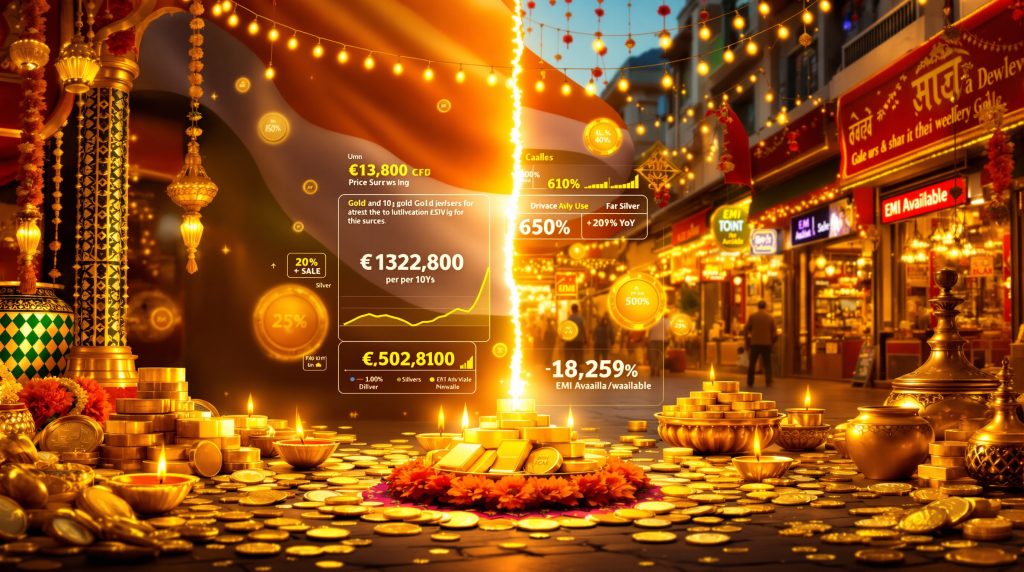Why Record Gold Prices Are Transforming India's Festival Shopping Habits
The 2025 Dhanteras festival witnessed a dramatic shift in Indian gold purchasing behaviour as record gold prices shift Indian festive demand toward coins over jewellery. This transformation reflects broader changes in how consumers approach precious metals during culturally significant periods.
Local gold prices reached unprecedented levels during the festival, closing at ₹127,008 per 10 grams after touching a record high of ₹132,294 rupees. This represents an increase of more than 60% compared to the previous year's Dhanteras, fundamentally altering purchasing decisions across the world's second-largest gold consuming nation.
The Price Barrier That Changed Everything
The manufacturing premium attached to jewellery purchases creates an additional financial burden for consumers already facing elevated gold prices. Buyers typically pay 10-20% of the base gold price in manufacturing charges for jewellery, making ornamental pieces significantly more expensive than investment alternatives like coins and bars.
This pricing structure has become particularly challenging as premium rates reached unprecedented levels. Indian dealers quoted premiums up to $25 per ounce above official domestic prices during the festival week, representing the highest premium levels seen in more than a decade. These premiums include 6% import duties and 3% sales levies, further increasing the total cost burden.
Despite cultural traditions that consider Dhanteras auspicious for gold purchases, consumers demonstrated remarkable adaptability in maintaining their precious metals buying whilst adjusting their product preferences. Furthermore, our record gold price analysis reveals how these elevated levels affected global markets beyond India's borders. The festival remains one of the busiest gold-buying occasions globally, but the nature of those purchases has evolved dramatically.
Consumer Behaviour Shifts Toward Investment Products
The demand pattern transformation became evident in sales volume comparisons between different gold product categories. Gold jewellery demand experienced a significant decline of nearly 30% compared to the previous year's festival, whilst coins and bars saw unprecedented demand according to industry associations.
Overall gold sales during the 2025 Dhanteras were 10-15% lower in volume terms compared to the previous year, yet total transaction values increased sharply due to elevated pricing. This indicates consumers purchased smaller quantities whilst paying substantially more per unit, reflecting a strategic approach to maintaining cultural traditions within budget constraints.
Investment-Grade Products Dominate Sales
Plain gold coins and bars emerged as the preferred choice for festival buyers seeking to honour traditions whilst maximising value. These products offer pure gold exposure without the manufacturing premium associated with ornamental jewellery, making them attractive to price-conscious consumers.
The shift toward investment products also reflects changing perceptions about gold's role in personal wealth management. Rather than viewing gold primarily as ornamental or ceremonial, consumers increasingly approach it as a strategic asset allocation within their broader investment portfolios. In addition, understanding the gold market relationship guide helps explain why investors view gold as a crucial portfolio component during market uncertainty.
Jewellery stores adapted to this demand pattern by extending operating hours significantly, with many retailers remaining open until midnight to capture maximum festival buying activity. The extended trading hours reflect both the concentrated nature of festival demand and retailers' efforts to maximise sales despite challenging price conditions.
Silver Benefits from Gold's Price Rally
Silver experienced robust demand during the festival period, driven by what industry experts describe as a stellar price rally for the white metal. This alternative precious metal gained appeal as investors sought exposure to precious metals at more accessible price points compared to gold.
Market sentiment surrounding silver has become increasingly positive, with dealers indicating that investors believe the metal could outperform gold in current market conditions. Consequently, silver market dynamics have shifted significantly, creating new opportunities for investors looking beyond traditional gold purchases. This expectation has contributed to strong demand for silver coins, bars, and jewellery throughout the festive period.
Exchange-Traded Fund Inflows Surge
Higher returns from precious metals have attracted significant inflows into physically backed gold and silver exchange-traded funds in recent months. These investment vehicles provide exposure to precious metals without the storage and security concerns associated with physical ownership.
The ETF performance reflects broader institutional and retail investor interest in precious metals as portfolio diversification tools. For instance, our ETC investment guide demonstrates how these funds offer liquidity advantages over physical metals whilst maintaining direct exposure to underlying commodity price movements.
Retail Industry Adaptation Strategies
Jewellery retailers implemented various strategies to maintain customer engagement despite challenging price conditions. Industry participants offered substantial discounts on manufacturing charges to stimulate demand throughout the festive period and approaching wedding season.
These promotional approaches aim to offset some of the price sensitivity created by record gold levels. By reducing the premium component of jewellery purchases, retailers attempt to bring total costs closer to investment product pricing whilst maintaining their ornamental product focus.
Operational Adjustments for Festival Demand
The retail sector made significant operational adjustments to accommodate changed buying patterns. Extended operating hours became standard practice, with stores remaining open until midnight during peak festival periods and continuing operations into the following afternoon as celebrations extended.
Inventory management also shifted to reflect new demand patterns, with retailers increasing allocation toward coins and small bars relative to elaborate jewellery collections. This adjustment helps ensure adequate supply of preferred products whilst reducing exposure to slower-moving ornamental inventory.
Market Dynamics and Premium Pricing
The premium pricing structure in India's gold market reached exceptional levels during the festival period. The $25 per ounce premium represents not just the highest level in over a decade, but also indicates supply-demand imbalances within the domestic market.
These premium levels reflect various factors including import costs, domestic demand intensity, and logistical considerations. The 6% import duty and 3% sales levy components are fixed, meaning the additional premium reflects pure market dynamics and dealer margin requirements.
| Metric | 2024 Festival | 2025 Festival | Change |
|---|---|---|---|
| Gold Price (₹/10g) | ~₹79,000 | ₹127,008-₹132,294 | +60%+ |
| Jewellery Demand | Baseline | 30% decline | -30% |
| Overall Volume | Baseline | 10-15% lower | -10-15% |
| Premium Levels | Historical avg | Up to $25/oz | Decade high |
Cultural Traditions Meet Economic Reality
Dhanteras holds deep cultural significance as the start of the five-day Diwali festival of lights, traditionally considered the most auspicious time for gold purchases. This cultural importance creates a natural support level for demand, even when economic conditions become challenging.
The 2025 festival demonstrated remarkable consumer adaptability in maintaining cultural practices whilst adjusting to economic constraints. Rather than abandoning gold purchases entirely, buyers modified their approach to preserve traditions within altered budget parameters. Moreover, analyses from mining.com confirm these behavioural shifts extend beyond individual purchasing decisions to affect broader market trends.
Wealth Preservation Motivations
Beyond cultural significance, gold purchases during festivals serve wealth preservation functions that remain relevant regardless of price levels. India's consumers view gold as a hedge against inflation and currency devaluation, supporting demand even at elevated price points.
The investment-focused buying behaviour observed during 2025 Dhanteras reflects this wealth preservation priority. Consumers prioritised gold accumulation over ornamental display, suggesting a sophisticated understanding of the metal's financial characteristics. Furthermore, examining our historic gold surge explained provides crucial context for understanding why consumers are increasingly viewing gold as a strategic investment rather than merely decorative.
"The shift toward investment products during the 2025 Dhanteras festival may indicate a permanent change in Indian gold buying patterns, particularly if elevated prices persist through upcoming wedding seasons and future festivals."
Regional and Demographic Considerations
The transformation in buying patterns likely varies across different geographic regions and demographic segments within India. Metropolitan areas with higher disposable incomes may show different adaptation strategies compared to smaller cities and rural regions.
Wedding season implications also factor into retailer strategies and consumer planning. The industry's discount offerings on manufacturing charges aim to maintain demand momentum through both festive periods and the crucial wedding season that follows.
How Technology Shapes Modern Gold Buying?
Digital payment systems and online precious metals platforms have facilitated the shift toward investment products by making coin and bar purchases more accessible. These technological developments reduce friction in investment-grade gold transactions compared to traditional jewellery buying experiences.
The growth of physically backed ETFs also provides modern alternatives to direct physical ownership, appealing particularly to younger demographics who may prefer liquid investment vehicles over traditional storage-intensive approaches.
Market Outlook and Investment Implications
Current market conditions suggest the transformation in Indian gold buying patterns may persist beyond the immediate festival period. Record pricing levels that drove 2025 behaviour changes could establish new baseline consumer preferences favouring investment products over ornamental purchases.
Industry participants must adapt business models to accommodate these shifted preferences whilst maintaining cultural relevance. The balance between investment and ornamental products in retail inventory management becomes crucial for sustainable operations.
Strategic Consumer Approaches
For consumers navigating elevated gold prices, several strategic approaches emerge from the 2025 Dhanteras experience:
- Prioritise investment-grade products to minimise premium costs
- Consider silver alternatives for cultural purchases at lower price points
- Utilise extended trading hours to compare options across multiple retailers
- Take advantage of manufacturing charge discounts when available
- Evaluate ETF alternatives for portfolio exposure without physical storage
Economic Significance for India's Gold Market
The behavioural shifts observed during 2025 Dhanteras carry broader implications for India's position in global gold markets. As the world's second-largest consumer, changes in Indian demand patterns influence international pricing and supply chain dynamics.
Import pattern modifications may result from the continued preference for investment products over manufactured jewellery. This could affect India's trade balance and the domestic manufacturing sector's employment and production levels. Additionally, insights from the Gold Organisation's India market update highlight how these shifts reflect broader economic considerations beyond immediate price concerns.
However, the premium pricing experienced during the festival also highlights India's market sensitivity to supply constraints and the potential for domestic demand to exceed comfortable supply levels during peak periods. Consequently, record gold prices shift Indian festive demand toward coins over jewellery represents not just a temporary adjustment but potentially a fundamental restructuring of how India approaches precious metals consumption.
Disclaimer: This analysis is based on market conditions and industry reports from the 2025 Dhanteras period. Future gold prices and consumer behaviour patterns may vary significantly based on global economic conditions, currency fluctuations, and domestic policy changes. Potential investors should conduct independent research and consider their financial circumstances before making precious metals investment decisions.
Ready to Capitalise on Precious Metals Market Movements?
Discovery Alert's proprietary Discovery IQ model delivers real-time alerts on significant ASX mineral discoveries, including gold and silver exploration companies positioned to benefit from current market conditions. Subscribers gain instant access to actionable trading opportunities, turning complex market dynamics into clear investment insights ahead of the broader market through Discovery Alert's comprehensive platform.




